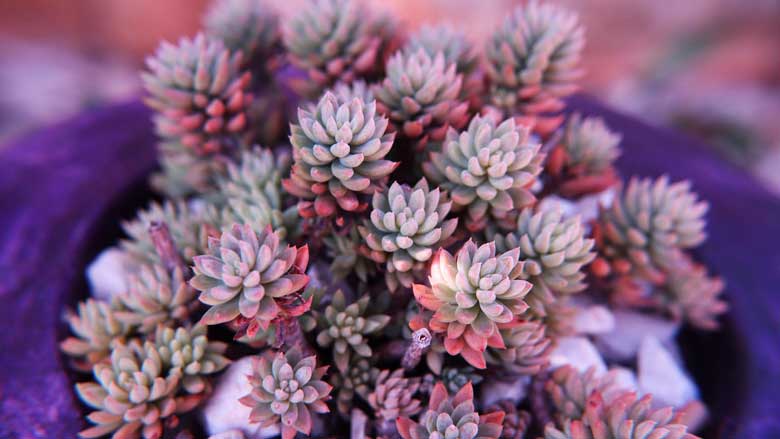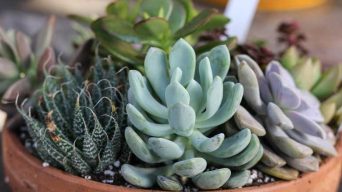Anyone interested in gardening knows that succulents are an excellent option for anyone looking to have plants in their home or office.
They’re low-maintenance, come in various shapes and sizes, and are perfect for anyone who doesn’t have a green thumb.
What many people don’t know, however, is that you can stress succulents to get beautiful and colorful plants!
This article will discuss how to stress succulents safely and get the most vibrant plants possible.
What is Succulent Stress?
Succulent stress is when a plant is placed in an environment outside of its normal conditions.
This could be anything from changes in temperature, light, or water.
While this might sound harmful, stress causes succulents to produce more vibrant colors and interesting shapes.
Succulent stress is an adaptive response that causes the formation of anthocyanin and carotenoid as a result of environmental stresses.
These pigments are what give succulents their beautiful colors.
For example, if you stress a succulent plant that is usually green, it may turn red to protect itself from the sun.
The different colors that succulents can turn are often stunning and make an exciting addition to any garden.
However, not all stress is good for succulents. Too much stress can kill the plant.
It is essential to know how to stress your succulents safely to enjoy their beauty without harming them.
Signs of Stress in Succulents
The first step to stress succulents safely is to identify when they are starting to feel stress.
When succulents are moderately stressed, they will often change color. This is normal and not cause for alarm. This is a sign that the plant is adapting to its new environment.
If the stress is more severe, the succulent may start to wilt or lose leaves.
This is a sign that the plant is not coping well with the stress and needs to be moved back to its normal environment as soon as possible.
This is a sign that the plant is in danger and needs to be moved back to its normal environment as soon as possible.
Some other signs of stress in succulents include:
- Changes in color
- Stretching
- Dropping leaves
- Wilting
- Soft or mushy leaves
- Leaning over
- Curling leaves
Types of Stress for Succulents
There are many different types of stress that can affect succulents.
Some common stressors include:
- Temperature stress
- Light stress
- Water stress
- Nutrient stress
- Pest stress
Each type of stressor can affect succulents in different ways.
It is important to be aware of the different types of stress so that you can stress your succulents safely.
Temperature Stress
One of the most common stressors for succulents is temperature stress.
Succulents are very sensitive to changes in temperature. They can quickly go into shock if the temperature is too high or too low.
When moving succulents from one environment to another, it is important to adjust them to the new temperature slowly.
If you are stress succulents for a garden, it is important to make sure that the garden’s temperature is within the succulent’s range.
Light Stress
Another common stressor for succulents is light stress.
Succulents need a certain amount of light to thrive, and too much or too little light can stress them.
Succulents have more vibrant colors in bright light.
However, when succulents are exposed to too much direct sunlight, they can quickly become sunburned.
This will cause the succulent leaves to turn brown and may even kill the plant.
When exposed to too little light, succulents will often etiolate or stretch.
This is when the plant grows taller and thinner in an attempt to reach the light.
While this doesn’t kill the plant, it is not healthy and can make it more susceptible to stress and pests.
Water Stress
Water stress is another stressor that can affect succulents.
Succulents need water, but they can also quickly drown if given too much water.
It is important to make sure that the soil is dry before watering succulents and give them only enough water to keep the soil moist.
Too much water will cause the roots to rot and may kill the plant.
Nutrient Stress
Succulents also need nutrients to thrive.
If the soil is not rich in nutrients, the succulents will start to stress.
This can often be seen as a yellowing of the leaves, and the plant may start to droop.
Succulents can also stress from too much fertilizer.
It is important only to fertilize succulents when they need it and use a light hand when doing this.
Pest Stress
Lastly, succulents can also stress from pests.
Many different types of pests can infest succulents, including:
- Spider mites
- Mealybugs
- Aphids
- Whiteflies
- Scale insects
Each type of pest can cause stress in different ways.
This is why it is important to check for pests and treat any infestations quickly.
Stress is a common issue for succulents, but it doesn’t have to be challenging to manage.
By understanding the different types of stress and how to deal with them, you can stress your plants safely without harming them.
How to Stress Succulents to Get Colorful Succulents
Stressing your succulents is a great way to get beautiful and colorful plants.
Succulents are very stress-sensitive, so even small changes in their environment can cause them to change color.
How to Sun Stress Succulents
Succulents should be stressed in full sun for the best results.
The more intense the light, the quicker and more dramatic the color change will be.
However, most types of succulents thrive in bright indirect light, so make sure to stress your plants in a location where they will get plenty of light.
When stressing succulents in the sun, make sure to keep an eye on them and remove them from the stressor if they start to get too hot.
When succulents are exposed to too much direct sunlight, they can start to dehydrate and may even get sunburned.
So, how do you stress succulents in the sun?
There are a few different ways to stress succulents in the sun.
One way is to place them in a spot that gets direct sunlight for part of the day and then move them to a shadier location when they start to get too hot.
Another option is to stress them gradually by slowly increasing the amount of time they spend in direct sun each day.
A third option is to stress them all at once by placing them in direct sunlight exposure for an extended period.
Whatever method you choose, make sure to monitor your plants closely and stress them only as much as they can handle.
By stressing succulents in the sun, you can create beautiful plants with vibrant colors that will add a splash of color to your garden or home.
How to Water Stress Succulents
Water stress is another great way to stress succulents and get beautiful results.
Water stress is when a plant does not get enough water and starts to wilt.
This stressor can cause succulents to change color, usually to a deeper or more vibrant hue.
To water stress your succulents, allow the soil to dry out completely between watering.
Do not water your plants for a week or longer, and then water them deeply.
Make sure to monitor your plants closely during this process, as they may start to wilt if they are not getting enough water.
If your plants start to wilt, water them and let the soil dry out again.
You can create beautiful plants with deep, rich colors by stressing succulents with water.
How to Cold Stress Succulents
Cold stress is another great way to stress succulents and create beautiful plants.
To cold stress your succulents, place them in a location where they will experience temperatures below 50 degrees Fahrenheit for an extended period.
Make sure to monitor your plants closely during this process, as they may start to experience frost damage if the temperature is too cold.
When succulents are subjected to cold stress, they will usually start to change color almost immediately.
The most common colors that succulents turn when exposed to cold stress are purple, red, and black.
You can create beautiful plants with unique and interesting colors by exposing your succulents to cold stress.
How to Heat Stress Succulents
Heat stress is another great way to stress succulents and create beautiful plants.
To heat stress your succulents, place them in a location where they will experience temperatures above 80 degrees Fahrenheit for an extended period.
Make sure to monitor your plants closely during this process, as they may start to experience heat damage if the temperature is too hot.
When succulents are subjected to heat stress, they will usually start to change color almost immediately.
But be careful, succulents can die if the stress is too much.
The most common colors that succulents turn when exposed to extreme heat are yellow, orange, and red.
You can create beautiful plants with unique and interesting colors by exposing your succulents to heat stress.
How to Stress Succulents With Grow Lights?
Succulents are great indoor plants, and stress them with grow lights is a great way to get beautiful plants for your home.
Grow lights are artificial light sources designed to mimic the sun’s rays.
They can be used to stress succulents to create colorful plants.
When stressing succulents with grow lights, it is important to use the correct type of light.
Most succulents need full-spectrum light to thrive, so make sure to use grow lights that emit all of the colors of the spectrum.
It is also important to stress your plants gradually by slowly increasing the amount of time they spend under the grow lights each day.
Make sure to monitor your plants closely during this process, as they may start to experience stress if they are not getting enough light.
By stressing succulents with grow lights, you can create beautiful plants that will add a splash of color to your home.
Tips on How to Stress Succulents Safely
Did you know that stress can actually be good for succulents?
That’s right, stress can cause succulents to produce more vibrant colors and interesting shapes.
However, it is important to stress your plants safely so that they do not become harmed in the process.
Here are a few tips on how to stress succulents safely:
- Start with healthy plants. It is vital only to stress healthy plants, as they are more susceptible to pests and disease.
- Choose the right type of succulents. Not all succulents respond well to stress, so choosing the right kind of plant is crucial. Most succulents that are native to the desert react well to stress, while succulents from other climates may not.
- Choose the right stressor. Not all stressors are created equal. Some stressors are more harmful than others. Make sure to choose a stressor that is safe for your plant.
- Start slowly. It is important to stress your plants gradually so that they have time to adapt to the new conditions.
- Monitor your plants closely. When you first start stressing your plants, it is essential to monitor them closely. This way, you can catch any problems early and prevent them from becoming bigger issues.
- Know when to stop. Just like with anything else, too much stress can be a bad thing. If you notice your plants starting to struggle, back off on the stressors.
You can stress your succulents safely and produce beautiful and interesting plants by following these tips.
How Long Does It Take To Stress Succulents?
It can take anywhere from a few days to a few weeks to stress succulents successfully.
How you stress your plants will also play a role in how long it takes.
For example, exposing your plants to cold stress will usually start to change color almost immediately.
However, if you stress your plants with grow lights, it will take longer for them to start showing changes.
It is essential to be patient and let the stress process run its course.
If you try to hurry it along, you may end up harming your plants.
Final Thoughts
Stressing succulents is a great way to create beautiful and colorful plants.
You can create deep, bright colors that will add a splash of color to your garden or home by stressing your plants.
There are a few different ways to stress your plants, so make sure to choose the method that best suits you and your succulent’s needs.
When stress succulents, it is important to do so safely.
Monitor your plants closely during the stress process and be prepared to back off if they start to struggle.
With a little bit of patience and care, you can create some stunning succulent plants using this easy method.







